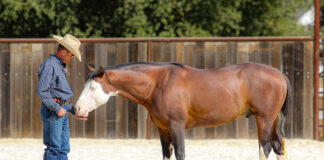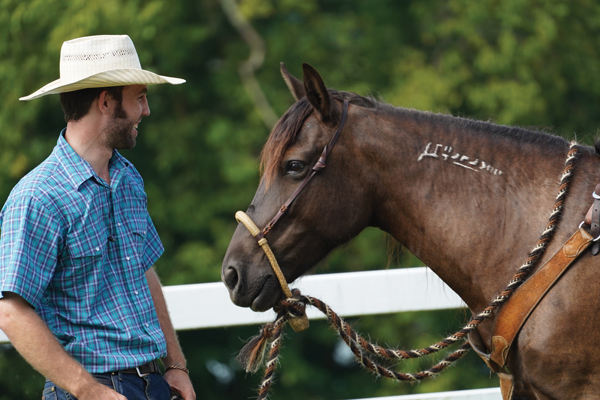
The round pen used to be a rider’s best friend when it came to dealing with a horse that was deemed naturally hyper or easily excitable. The longe line was a common tool in the trailer at every show, with the idea that cantering circles to exhaustion would get the horse ready to perform his best. But, as natural horsemanship trainer Colton Woods points out, a lot of that work can be done at home and on the ground without working both you and your horse to a lather.
1. Look at the Horse’s Health
Any time you have a horse that’s acting up, it’s important to work with your veterinarian to make sure that your nervous horse isn’t suffering from something causing him pain or discomfort. Woods is always looking to address the horse’s digestive system.
“A lot of times with anxious horses, that anxiety can lead to stomach ulcers, just like us,” he explains. “If we get really anxious, a lot of times our stomach doesn’t feel good. Horses will have that similar feeling.”
2. Refocus the Focus
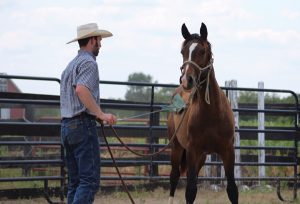
“All horses will focus on something, especially an anxious or hyper horse,” says Woods. “Personally, I’d rather him focus on me. If I have a horse that has some pent-up energy, whether it’s from stress or hype, what that tells me is the horse’s mind is somewhere else. Mentally, he’s not present in the moment. But when we’re present, we’re focused.”
For example, Woods had a cutting-bred horse in his barn exhibiting high energy.
“I noticed that he needed to feel like he could go somewhere,” says Woods. “He wasn’t really present with me, but if I asked him to do something, he wanted to be quick about his response.”
Because Woods didn’t want to fight with the horse, he took just 10 minutes to let him do an exercise where he could use his natural urge for cutting—but he had to meet Woods’ request.
“That horse didn’t feel like I was telling him ‘no’ because I was directing that energy he had,” he says. “After a few minutes, he felt like he was good and had gotten it out of his system. Then, because I went with him instead of against him, he started to focus on me a lot more. Even when the doors of the barn rattled in the wind, he didn’t spook.”
3. Practice Being Present
If everything seems good health-wise, the next culprit to the horse’s behavior could be at the opposite end of the lead rope—ourselves. Woods recognizes that a lot of people struggle with a sensitive horse because they’re not present with their horse—they’re thinking about 72 other things that are going on in their lives.
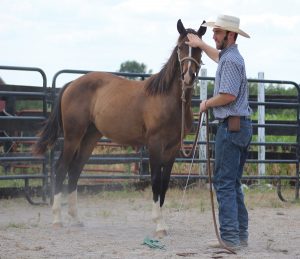
A lot of times, whatever problem we have to work on with our horses starts with us. We need to make sure we’re present with our horses so they can be present with us.
The idea of “taking a deep breath” may sound cliché, but if you do that first, you’ll find that the horse will take a deep breath, too. Relax your shoulders, engage your core, relax your lower back (even if you’re standing on the ground), and just breathe. Try to feel the oxygen go through your body. Take that second to relax with your horse and let him do the same thing.
Woods suggests watching for these signs:
■ A twitching nose.
■ How he blinks: if he blinks with small, shutter-type blinks, or is barely blinking at all, that means he’s stressed. But if he’s taking big, heavy blinks and his eye is soft, it’s a sign that he’s relaxed.
■ Is he chewing or licking? That’s a sign that he’s relaxed.
4. Calculated Corrections
Sometimes a nervous horse spooks or overreacts to the point where we feel we must reprimand or correct him immediately. Woods cautions that if you go to reprimand your horse, take a second to think first. Are you doing it in an aggressive manner and out of emotion, as opposed to calculated?
“When we start making these emotion-based decisions, the horse goes into the fight or flight response a lot sooner,” says Woods.
“We don’t want him to go there because he can’t learn in that state of mind.”
Woods says this is where we must check ourselves first and evaluate if this is something we can get our horse over. Can you get your horse over this while in the saddle, or are you more comfortable correcting him on the ground? Do you need to enlist help from a professional or a friend?
5. No Easy Supplement
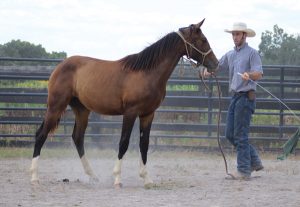
The previous four steps all take time and intent on your part. Unfortunately, there is no easy fix when it comes to dealing with a hyper or stressed horse. While there might be products lining the shelves claiming to calm your horse, Woods cautions that they could be too good to be true.
However, there are occasions when a medical condition could necessitate a prescription or recommendation from your vet. This allows everyone to stay safe and ensures that the horse has a good experience. “When it comes to working with your horse and needing to fix an issue, there are two variables; there are times to get things done, and times to educate your horse,” says Woods.
“But the real key is the preparation for what is going to be asked of your horse later.”
This article about how to calm a nervous horse appeared in the June 2020 issue of Horse Illustrated magazine. Click here to subscribe!




